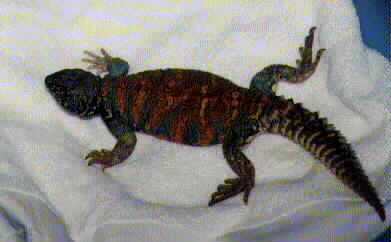These lizards can inflate their bodies when warm or emotional.

|
Another species, Acanthinurus, is as large as the
Aegypticus, more rare and with the vivid hues of the Ornatus without
the bars. It has a blackish head with strongly whorled tail and reticulated
markings on the back. These are very rare. All four feet have five well-clawed
toes used in aiding these agile climbers. They have a thick fat tail that
has spines arranged in whorls. They use this tail both for defense and for
a fat/water reserve.
In the wild these lizards inhabit the very hot, arid zones feeding on many
types of vegetative matter including tough shrubs. They rarely encounter
water in the wild and in captivity it is imperative that they be kept dry
and free of moist bedding to avoid sickness. They get most of the water
in their diet from the food they eat and the majority of the water in their
urine is resorbed by their bodies. During extreme drought and food scarcity,
they can use the water from the fat in their tails to stay alive. They give
off salts through glands along the nasal passages and you may see salt crusts
at the nostril openings at times.
They are good eaters
if the temperature is kept within their required range of 85 to 98 degrees
F. I suggest maintaining a normal day/night difference by dropping it to
70 degrees F at night. We feed ours a salad of mixed greens including most
lettuces especially kale, endive, romaine, etc. but excluding nutritionless
iceberg. We also offer finely chopped carrots, sweet potatoes and broccoli,
squash, green beans and canned corn or soaked lentils (and certain beans).
You can also offer dandelion greens and their flowers, clover and cabbage.
Small or crushed rodent chow can also be used as well as leafy alfalfa hay.
They can be given certain non-toxic flowers such as rose, hibiscus, bergamot
petals, borage, chives, cress, dill, fennel, lavender, thyme, mints (excluding
pennyroyal), oregano, sage, rosemary, safflower, sweet cicely, calendula,
carnation, pansy, marigold, and nasturtiums. I recommend that you only give
petals because some stems and calyxes could be toxic. When you prepare their
meal be certain that all vegetables and flowers are free of pesticides and
fertilizers which can be harmful to them. There are probably many native
flowers and weeds that could be given to these lizards however, check with
your county agriculture extension agent BEFORE introducing any to their
diet. Some animals, especially youngsters will eat some insects such as
crickets and super meal worms.
Our exact regimen goes as follows: Turn on heat lamps and basking spots
in the morning so that the temperature is around 90-95 degrees F. About
1:00 we turn off the heat lamps but leave on the spots and feed at that
time, a wonderful salad as mentioned above. At night, we turn off the spots
so the temperature drops to about 70 degrees F. They usually eat after 8:00
pm, believe it or not.
We do not give water in dishes but do hang a water bottle an the side just
because it makes us feel better. They rarely use it deriving most
of their moisture from their food. If they eat lots of dried alfalfa, they
will drink water.
We place rabbit pellets (instead of sand) about 5 inches deep for substrate
to prevent impaction from sand ingestion with their food. Be sure to provide
hiding places such as clay or plastic pipes, rocks, tree limbs, etc. Their
food can be hung from wires (heads and leaves of lettuce) or placed on flat
pans. The lizards have no discernible odor of their own and the only thing
we smell is the rabbit pellets. They excrete a hard dry pellet and rarely
have urine of any noticeable amount.
Our lizards are not hostile. We have NEVER encountered an aggressive animal
to date. They prefer to get out of the way when first introduced to their
environment but soon settle down to your routine. They tame readily and
can learn to eat from your hand. While the lizard is learning to accept
both you AND its new environment, it is imperative that you never upset
or scare it by grabbing at it with fast movements. Be calm and give it a
chance to see that it is YOU who is not a threat. It will soon learn that
it does not have to run or be afraid of you.
Uromastyx are egg layers and can lay clutches of up to 20 eggs when fully
mature. Eggs can be incubated in an incubator on moist vermiculite with
a temperature of about 80-85 degrees. Babies are 2" to 3" long.
Many internal parasites can be detected by means of fecal flotation. Panacur
(fenbendazole) is often given. Often three treatments are required at 2
week intervals. Ivermectrin is also used but to figure the dose is difficult.
Giving the oral medication is not difficult with a syringe. You can easily
mix it with their food however.
These animals are good climbers if they can get a hold on the surface with
their claws. We suggest a large terrarium with a top and a basking spot
light and plenty of interesting places to climb and in which to hide. They
require ultraviolet radiation to synthesize Vitamin D3 which is necessary
to absorb calcium. The UV-B rays that are necessary are found in natural
sunlight or some special reptile lights so be sure to provide one or the
other. Their gorgeous colors, in the case of Ornatus or Acanthinurus,
make them a most attractive addition to your collection. Aegypticus are
not colorful, but are so prehistoric looking and unusual they make a wonderful
menagerie addition and give a flavor of Jurassic ParkÒ to your decor.


